Input interpretation

H_2O water + KCl potassium chloride ⟶ Cl_2 chlorine + H_2 hydrogen + KOH potassium hydroxide
Balanced equation
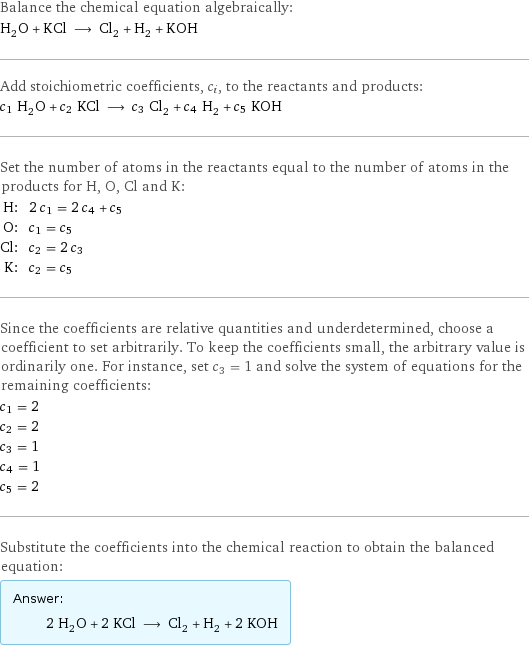
Balance the chemical equation algebraically: H_2O + KCl ⟶ Cl_2 + H_2 + KOH Add stoichiometric coefficients, c_i, to the reactants and products: c_1 H_2O + c_2 KCl ⟶ c_3 Cl_2 + c_4 H_2 + c_5 KOH Set the number of atoms in the reactants equal to the number of atoms in the products for H, O, Cl and K: H: | 2 c_1 = 2 c_4 + c_5 O: | c_1 = c_5 Cl: | c_2 = 2 c_3 K: | c_2 = c_5 Since the coefficients are relative quantities and underdetermined, choose a coefficient to set arbitrarily. To keep the coefficients small, the arbitrary value is ordinarily one. For instance, set c_3 = 1 and solve the system of equations for the remaining coefficients: c_1 = 2 c_2 = 2 c_3 = 1 c_4 = 1 c_5 = 2 Substitute the coefficients into the chemical reaction to obtain the balanced equation: Answer: | | 2 H_2O + 2 KCl ⟶ Cl_2 + H_2 + 2 KOH
Structures

+ ⟶ + +
Names

water + potassium chloride ⟶ chlorine + hydrogen + potassium hydroxide
Reaction thermodynamics
Enthalpy
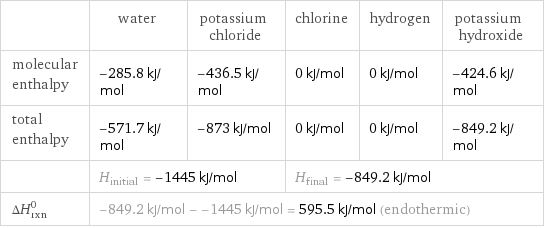
| water | potassium chloride | chlorine | hydrogen | potassium hydroxide molecular enthalpy | -285.8 kJ/mol | -436.5 kJ/mol | 0 kJ/mol | 0 kJ/mol | -424.6 kJ/mol total enthalpy | -571.7 kJ/mol | -873 kJ/mol | 0 kJ/mol | 0 kJ/mol | -849.2 kJ/mol | H_initial = -1445 kJ/mol | | H_final = -849.2 kJ/mol | | ΔH_rxn^0 | -849.2 kJ/mol - -1445 kJ/mol = 595.5 kJ/mol (endothermic) | | | |
Gibbs free energy
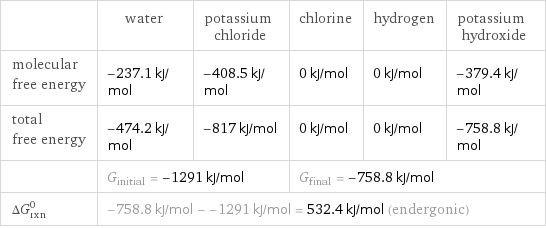
| water | potassium chloride | chlorine | hydrogen | potassium hydroxide molecular free energy | -237.1 kJ/mol | -408.5 kJ/mol | 0 kJ/mol | 0 kJ/mol | -379.4 kJ/mol total free energy | -474.2 kJ/mol | -817 kJ/mol | 0 kJ/mol | 0 kJ/mol | -758.8 kJ/mol | G_initial = -1291 kJ/mol | | G_final = -758.8 kJ/mol | | ΔG_rxn^0 | -758.8 kJ/mol - -1291 kJ/mol = 532.4 kJ/mol (endergonic) | | | |
Entropy
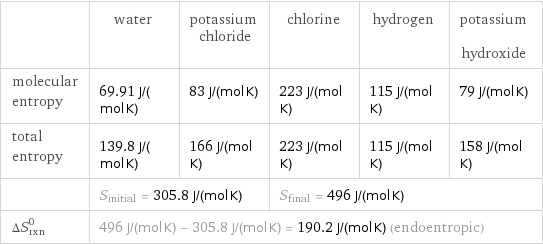
| water | potassium chloride | chlorine | hydrogen | potassium hydroxide molecular entropy | 69.91 J/(mol K) | 83 J/(mol K) | 223 J/(mol K) | 115 J/(mol K) | 79 J/(mol K) total entropy | 139.8 J/(mol K) | 166 J/(mol K) | 223 J/(mol K) | 115 J/(mol K) | 158 J/(mol K) | S_initial = 305.8 J/(mol K) | | S_final = 496 J/(mol K) | | ΔS_rxn^0 | 496 J/(mol K) - 305.8 J/(mol K) = 190.2 J/(mol K) (endoentropic) | | | |
Equilibrium constant
![Construct the equilibrium constant, K, expression for: H_2O + KCl ⟶ Cl_2 + H_2 + KOH Plan: • Balance the chemical equation. • Determine the stoichiometric numbers. • Assemble the activity expression for each chemical species. • Use the activity expressions to build the equilibrium constant expression. Write the balanced chemical equation: 2 H_2O + 2 KCl ⟶ Cl_2 + H_2 + 2 KOH Assign stoichiometric numbers, ν_i, using the stoichiometric coefficients, c_i, from the balanced chemical equation in the following manner: ν_i = -c_i for reactants and ν_i = c_i for products: chemical species | c_i | ν_i H_2O | 2 | -2 KCl | 2 | -2 Cl_2 | 1 | 1 H_2 | 1 | 1 KOH | 2 | 2 Assemble the activity expressions accounting for the state of matter and ν_i: chemical species | c_i | ν_i | activity expression H_2O | 2 | -2 | ([H2O])^(-2) KCl | 2 | -2 | ([KCl])^(-2) Cl_2 | 1 | 1 | [Cl2] H_2 | 1 | 1 | [H2] KOH | 2 | 2 | ([KOH])^2 The equilibrium constant symbol in the concentration basis is: K_c Mulitply the activity expressions to arrive at the K_c expression: Answer: | | K_c = ([H2O])^(-2) ([KCl])^(-2) [Cl2] [H2] ([KOH])^2 = ([Cl2] [H2] ([KOH])^2)/(([H2O])^2 ([KCl])^2)](../image_source/797b3cecea2d70c9c18d57ba49f83f33.png)
Construct the equilibrium constant, K, expression for: H_2O + KCl ⟶ Cl_2 + H_2 + KOH Plan: • Balance the chemical equation. • Determine the stoichiometric numbers. • Assemble the activity expression for each chemical species. • Use the activity expressions to build the equilibrium constant expression. Write the balanced chemical equation: 2 H_2O + 2 KCl ⟶ Cl_2 + H_2 + 2 KOH Assign stoichiometric numbers, ν_i, using the stoichiometric coefficients, c_i, from the balanced chemical equation in the following manner: ν_i = -c_i for reactants and ν_i = c_i for products: chemical species | c_i | ν_i H_2O | 2 | -2 KCl | 2 | -2 Cl_2 | 1 | 1 H_2 | 1 | 1 KOH | 2 | 2 Assemble the activity expressions accounting for the state of matter and ν_i: chemical species | c_i | ν_i | activity expression H_2O | 2 | -2 | ([H2O])^(-2) KCl | 2 | -2 | ([KCl])^(-2) Cl_2 | 1 | 1 | [Cl2] H_2 | 1 | 1 | [H2] KOH | 2 | 2 | ([KOH])^2 The equilibrium constant symbol in the concentration basis is: K_c Mulitply the activity expressions to arrive at the K_c expression: Answer: | | K_c = ([H2O])^(-2) ([KCl])^(-2) [Cl2] [H2] ([KOH])^2 = ([Cl2] [H2] ([KOH])^2)/(([H2O])^2 ([KCl])^2)
Rate of reaction
![Construct the rate of reaction expression for: H_2O + KCl ⟶ Cl_2 + H_2 + KOH Plan: • Balance the chemical equation. • Determine the stoichiometric numbers. • Assemble the rate term for each chemical species. • Write the rate of reaction expression. Write the balanced chemical equation: 2 H_2O + 2 KCl ⟶ Cl_2 + H_2 + 2 KOH Assign stoichiometric numbers, ν_i, using the stoichiometric coefficients, c_i, from the balanced chemical equation in the following manner: ν_i = -c_i for reactants and ν_i = c_i for products: chemical species | c_i | ν_i H_2O | 2 | -2 KCl | 2 | -2 Cl_2 | 1 | 1 H_2 | 1 | 1 KOH | 2 | 2 The rate term for each chemical species, B_i, is 1/ν_i(Δ[B_i])/(Δt) where [B_i] is the amount concentration and t is time: chemical species | c_i | ν_i | rate term H_2O | 2 | -2 | -1/2 (Δ[H2O])/(Δt) KCl | 2 | -2 | -1/2 (Δ[KCl])/(Δt) Cl_2 | 1 | 1 | (Δ[Cl2])/(Δt) H_2 | 1 | 1 | (Δ[H2])/(Δt) KOH | 2 | 2 | 1/2 (Δ[KOH])/(Δt) (for infinitesimal rate of change, replace Δ with d) Set the rate terms equal to each other to arrive at the rate expression: Answer: | | rate = -1/2 (Δ[H2O])/(Δt) = -1/2 (Δ[KCl])/(Δt) = (Δ[Cl2])/(Δt) = (Δ[H2])/(Δt) = 1/2 (Δ[KOH])/(Δt) (assuming constant volume and no accumulation of intermediates or side products)](../image_source/441867cf0c9761a066f5ce02917b6eeb.png)
Construct the rate of reaction expression for: H_2O + KCl ⟶ Cl_2 + H_2 + KOH Plan: • Balance the chemical equation. • Determine the stoichiometric numbers. • Assemble the rate term for each chemical species. • Write the rate of reaction expression. Write the balanced chemical equation: 2 H_2O + 2 KCl ⟶ Cl_2 + H_2 + 2 KOH Assign stoichiometric numbers, ν_i, using the stoichiometric coefficients, c_i, from the balanced chemical equation in the following manner: ν_i = -c_i for reactants and ν_i = c_i for products: chemical species | c_i | ν_i H_2O | 2 | -2 KCl | 2 | -2 Cl_2 | 1 | 1 H_2 | 1 | 1 KOH | 2 | 2 The rate term for each chemical species, B_i, is 1/ν_i(Δ[B_i])/(Δt) where [B_i] is the amount concentration and t is time: chemical species | c_i | ν_i | rate term H_2O | 2 | -2 | -1/2 (Δ[H2O])/(Δt) KCl | 2 | -2 | -1/2 (Δ[KCl])/(Δt) Cl_2 | 1 | 1 | (Δ[Cl2])/(Δt) H_2 | 1 | 1 | (Δ[H2])/(Δt) KOH | 2 | 2 | 1/2 (Δ[KOH])/(Δt) (for infinitesimal rate of change, replace Δ with d) Set the rate terms equal to each other to arrive at the rate expression: Answer: | | rate = -1/2 (Δ[H2O])/(Δt) = -1/2 (Δ[KCl])/(Δt) = (Δ[Cl2])/(Δt) = (Δ[H2])/(Δt) = 1/2 (Δ[KOH])/(Δt) (assuming constant volume and no accumulation of intermediates or side products)
Chemical names and formulas

| water | potassium chloride | chlorine | hydrogen | potassium hydroxide formula | H_2O | KCl | Cl_2 | H_2 | KOH Hill formula | H_2O | ClK | Cl_2 | H_2 | HKO name | water | potassium chloride | chlorine | hydrogen | potassium hydroxide IUPAC name | water | potassium chloride | molecular chlorine | molecular hydrogen | potassium hydroxide
Substance properties
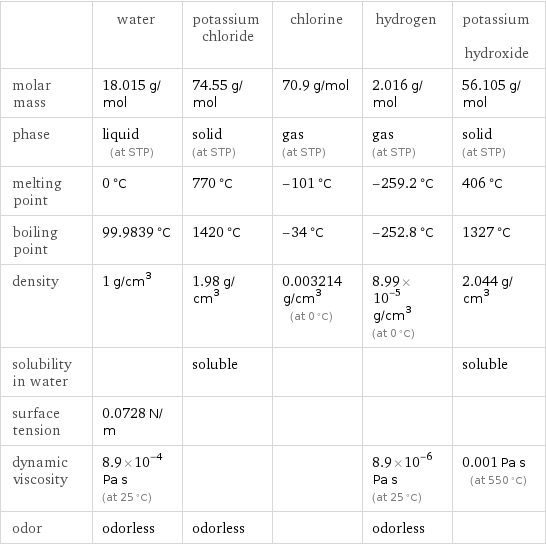
| water | potassium chloride | chlorine | hydrogen | potassium hydroxide molar mass | 18.015 g/mol | 74.55 g/mol | 70.9 g/mol | 2.016 g/mol | 56.105 g/mol phase | liquid (at STP) | solid (at STP) | gas (at STP) | gas (at STP) | solid (at STP) melting point | 0 °C | 770 °C | -101 °C | -259.2 °C | 406 °C boiling point | 99.9839 °C | 1420 °C | -34 °C | -252.8 °C | 1327 °C density | 1 g/cm^3 | 1.98 g/cm^3 | 0.003214 g/cm^3 (at 0 °C) | 8.99×10^-5 g/cm^3 (at 0 °C) | 2.044 g/cm^3 solubility in water | | soluble | | | soluble surface tension | 0.0728 N/m | | | | dynamic viscosity | 8.9×10^-4 Pa s (at 25 °C) | | | 8.9×10^-6 Pa s (at 25 °C) | 0.001 Pa s (at 550 °C) odor | odorless | odorless | | odorless |
Units
